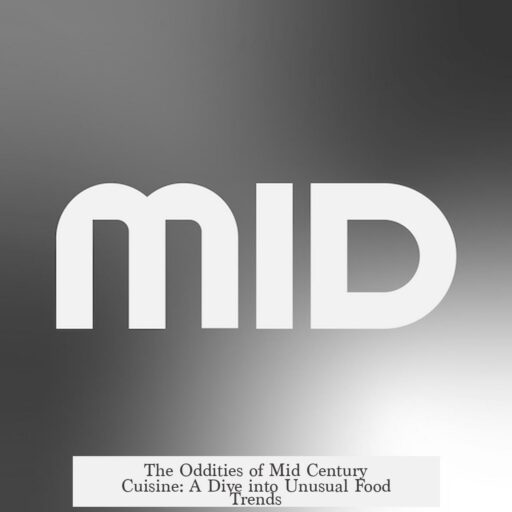Mid-century food seems weird primarily because it reflects a unique blend of industrial innovation, social aspiration, and convenience-driven cooking, all shaped by historical events such as World War II and rapid technological change. This era embraced processed ingredients and unusual flavor combinations in ways unfamiliar to modern palates.
The industrial age revolutionized food production. Before industrial gelatin manufacture, gelatin extraction was labor-intensive and expensive. It involved boiling down large volumes of bone broth and straining it carefully, restricting gelatin dishes like aspics to the wealthy. The advent of granulated gelatin powder by Charles Knox in the late 1800s democratized gelatin use, popularizing recipes involving aspics and jellied salads.
Household refrigerators arriving mid-century made these gelatin dishes easier to prepare and store, enhancing their popularity. Millions encountered colorful Jell-O molds, often branded with creative recipes integrating foods like canned fruit, vegetables, or even processed cheese. These dishes were as much about appearance as flavor—bright colors and molded shapes symbolized modernity and sophistication.
World War II had a large impact. Factories converted from arms production to food processing created a boom in affordable, processed ingredients. Techniques like freezing and dehydrating advanced during the war, so postwar America saw an explosion of convenience foods. The notion of “science in the kitchen” promised to reduce domestic labor and free up homemakers’ time. Packaged mixes, powdered sauces, and canned goods surged in popularity.
Mid-century cookbooks and advertising exploited these new products. Advertisers and recipe writers devised eye-catching and novel dishes designed to maximize sales of processed foods. This led to many odd recipes, such as gelatin salads containing 7-Up or processed cheese, and colorful molded desserts that prioritized shelf stability and ease of preparation over taste harmony.
Social aspirations also influenced food trends. Middle-class Americans sought to emulate elite European cooking by adopting French cooking techniques with modern American convenience foods. For example, “ham and bananas in hollandaise” combined exotic fruit (bananas), processed meat (ham), and powdered French sauce mix (hollandaise). The visually striking result was considered modern, elegant, and achievable for the average home cook.
Meals during this period often featured more courses than typical contemporary meals, ranging from breads and relishes to multiple salads, main dishes, side vegetables, and layered desserts. The breadth of courses encouraged variety but also experimentation, often with unusual ingredient pairings.
Historical culinary traditions also persisted but transformed. Aspics originated as a method for preserving food before widespread refrigeration. While mid-century homes typically had refrigerators, the retained popularity of aspics had shifted toward decorative, aesthetic appeal rather than preservation. Savory jellied dishes such as p’tcha or calf’s foot jelly remained known but evolved in presentation and ingredient use.
However, not all mid-century foods were appealing to all classes or tastes. “Government cheese,” canned goods, mayonnaise, boxed mixes, and gelatin distinguished poorer households’ diets from wealthier families, who often still sought “real” fresh foods. Over time, many of these convenience products became associated with lower socioeconomic status.
The flavor profiles of the era often lack the intensity or spice common today. Dishes were generally bland by modern standards, often avoiding strong seasonings. Yet, baking skills were reportedly high, with complex, multi-layered cakes developed from scratch, reflecting a serious domestic expertise in certain areas.
Modern perspectives often mock mid-century food for its odd combinations, gelatin overload, and industrial ingredients. Popular culture highlights strange dishes such as pineapple-olive gelatin salads or liver pâté molds as examples of culinary excess or misplaced faith in processed foods. Yet the fascination endures as a window into how social forces, technology, and marketing shaped everyday eating.
| Factor | Effect on Mid-Century Food |
|---|---|
| Industrialization of Food | Cheaper gelatin, processed ingredients, rise of convenience foods |
| World War II | Expanded food processing capacity, freezing and dehydrating technologies |
| Advertising and Recipe Development | Invented novel recipes to promote products; emphasis on visual appeal |
| Social Aspiration | Elite cooking techniques adapted for middle class with industrial foods |
| Historical Food Traditions | Legacy of aspics as decorative and flavor-enhancing dishes |
| Convenience and Homemaking Ideals | Quick, easy recipes supporting modern domestic roles |
Mid-century food’s oddities arose from a confluence of emerging industrial techniques, shifting social roles, marketing innovation, and historical influences. The resulting dishes appear strange today but were products of their time, embodying modern convenience, status aspirations, and industrial food abundance like no other era.
- Industrial gelatin production made jelly molds affordable and widespread.
- Post-WWII processing innovations led to many new convenience foods.
- Advertising created unusual recipes to sell processed ingredients.
- Mid-century meals had more courses and embraced novel combinations.
- Aspirations to emulate haute cuisine influenced ingredient and technique choices.
- Historical aspic traditions persisted but lost preservation roles.
- Modern views often mock their gelatin-heavy, mismatched flavors.




